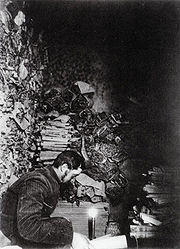
Tibetan Annals
Encyclopedia

Tibetan language
The Tibetan languages are a cluster of mutually-unintelligible Tibeto-Burman languages spoken primarily by Tibetan peoples who live across a wide area of eastern Central Asia bordering the Indian subcontinent, including the Tibetan Plateau and the northern Indian subcontinent in Baltistan, Ladakh,...
language found in the early 20th century in the "hidden library", the Mogao Grottoes near Dunhuang
Dunhuang
Dunhuang is a city in northwestern Gansu province, Western China. It was a major stop on the ancient Silk Road. It was also known at times as Shāzhōu , or 'City of Sands', a name still used today...
, which is believed to have been sealed in the 11th century CE. They form Tibet's earliest extant history.
Discovery
An enormous number of early manuscripts in a variety of languages were collected by A. Stein and P. Pelliot at the famous sealed-up Library Cave (no. 17) of the Mogao Grottoes and sent back to London and Paris respectively. Among these Dunhuang manuscriptsDunhuang manuscripts
The Dunhuang manuscripts is a cache of important religious and secular documents discovered in the Mogao Caves of Dunhuang, China during the early 20th century. Dating from the 5th to early 11th centuries, the manuscripts include works ranging from history and mathematics to folk songs and dance...
, The Tibetan Annals (or "Tibet’s First History") were found along with the "Old Tibetan Chronicle
Old Tibetan Chronicle
The Old Tibetan Chronicle is a scroll containing 536 lines, however the end is missing. There are Chinese Buddhist texts on the reverse side of the scroll...
", which was probably compiled between 800-840 CE.
The manuscript designated in the British Library
British Library
The British Library is the national library of the United Kingdom, and is the world's largest library in terms of total number of items. The library is a major research library, holding over 150 million items from every country in the world, in virtually all known languages and in many formats,...
in London and in the Bibliothèque Nationale in Paris are originally from the same original roll, 4.34 metres long and 0.258 metres wide.
Contents
The Annals begin with a very brief account of the early events of the reign of Songtsan Gampo, the first Tibetan Emperor. From the time the Chinese Princess WenchengPrincess Wencheng
Princess Wencheng was a niece of the powerful Emperor Taizong of China's Tang Dynasty, who left China in 640, according to records, arriving the next year in Tibet to marry the thirty-seven year old Songtsän Gampo the thirty-third king of the Yarlung Dynasty of Tibet, in a marriage of...
arrived in 643 CE until Songtsan Gampo's death in 650 it is possible to accurately date the entries. It then gives a dated, year-by-year précis of important events from 650 to 764 CE. For example, in 763 CE, Tibetan soldiers captured Chinese Tang dynasty
Tang Dynasty
The Tang Dynasty was an imperial dynasty of China preceded by the Sui Dynasty and followed by the Five Dynasties and Ten Kingdoms Period. It was founded by the Li family, who seized power during the decline and collapse of the Sui Empire...
's capital of Chang'an
Chang'an
Chang'an is an ancient capital of more than ten dynasties in Chinese history, today known as Xi'an. Chang'an literally means "Perpetual Peace" in Classical Chinese. During the short-lived Xin Dynasty, the city was renamed "Constant Peace" ; yet after its fall in AD 23, the old name was restored...
for fifteen days during the An Shi Rebellion
An Shi Rebellion
The An Lushan Rebellion took place in China during the Tang Dynasty from CE December 16, 755 to CE February 17, 763, beginning when general An Lushan declared himself emperor, establishing the rival Yan Dynasty in Northern China...
during which most of Tang Dynasty
Tang Dynasty
The Tang Dynasty was an imperial dynasty of China preceded by the Sui Dynasty and followed by the Five Dynasties and Ten Kingdoms Period. It was founded by the Li family, who seized power during the decline and collapse of the Sui Empire...
's military force was engaged in fighting the rebels. Of course, annals continued to be recorded after this date but, unfortunately, only one or two other minor fragments have survived. The Tibetan cyclic system dates are in much-faded red ink.
These accounts, generally accepted as sober court records, provide a priceless view of Tibet in its early phase of expansion and establishment as a powerful empire. They also provide a valuable way of checking and dating events mentioned in later Tibetan and Chinese historical records.
Neither the Annals nor the Chronicle make any mention of Buddhism in the reign of Songtsan Gampo. However, the Chronicle does say that, during the reign of king Khri srong lde brtsan (Trisong Detsen) (r. 755-ca.797 AD.), "The incomparable religion of the Buddha had been received and there were viharas (monasteries) in the centre as well as the borderlands of the country."

